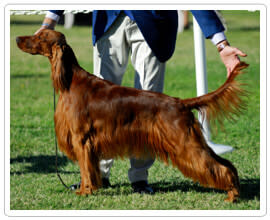
Have you ever wondered why your Terrier is so feisty? Or why your Whippet has a flexible back? Maybe you’ve wondered why your Bassett Hound's lips are pendulous?
Each purebred dog has an owner's manual, so to speak. It's called a breed standard and it represents in words the ideal picture for which breeders strive. Breed standards reflect our ideal dogs. They're also the criterion by which show dogs are evaluated. If you've never read your dog's breed standard, you really should put it on your must-do list, as it will give you a pretty good "picture" of why your dog is tall or short, resolute or courageous, smooth- or curly-coated, and why he digs under your rose garden or is manic about retrieving.
To a newcomer, a breed standard may seem nothing more than a cluster of strange-sounding words strung together on a piece of paper. However, it really is an outline of a perfect canine specimen—describing everything from height, weight, color and coat, to angulation of limbs, eye size, color, and shape, and what a dog should look like when he's moving. Yes, that's important too because a dog used for hunting fast rabbits and gazelles requires a certain body size for speed including long legs and a deep chest. A Whippet, for instance, that moved like a Bassett Hound would never reach speeds up to 35 mph. A Border Collie that moved like a Bulldog could never work sheep from morning 'til night.
Of course, no dog is perfect, and it's rare that a dog measures up to every aspect of the standard. Most breeds were developed for a particular task, such as herding, hunting, retrieving, or guarding, and each characteristic of the breed listed in the standard is there for a purpose. This culmination of history and purpose is how the earliest fanciers arrived at a breed's standard. An Australian Shepherd's almond-shaped eyes, for example, afford better protection in a working environment. A Jack Russell Terrier's tail is "set high,” which provides a good handhold when pulling him out of a rat hole. A Bassett Hound's "short legs and tight, close coat make them particularly useful in dense cover." The earliest of breeders—the forefathers of a breed—understood form and function.
Simplistic and Complicated
Breed standards are simultaneously simplistic and complicated. They are simplistic in that they describe the ideal quality, soundness, and beauty of the breed. What could be simpler? On the other hand, they can be complicated for newcomers—and even a few experienced breeders—because their sometimes-cryptic old-fashioned words and terminology make them a bit confusing to interpret. Some of the newer or revised standards are pretty straight forward, when compared to sorting through the terminology of 100-year-old Terrier standards.
Originally, people who knew dog breeds best, and those who worked with their dogs—usually stockmen and horsemen— wrote most of the standards, because they had extensive knowledge of dogs in working conditions. By simply looking at a dog, these old-timers could say if he was good or not. Therefore, when they wrote a standard, an assumption of dog knowledge and terminology was implied. They did not, for example, waste time writing that a dog had four legs. They understood balance meant "the relationship of one part to another, and all parts to the whole, in the desired proportions." They knew sound meant free of injury or an absence of lameness. The description of true arm (upper arm) says the dog is expected to have good reach. There was no need to spell it out in a standard.
Once you understand what chops has to do with your Boston Terrier's jaw, what clean-cut, dry, and strong has to do with your Aussie's head, what equable means in relation to your Bulldog's disposition, and what the heck they mean by a dog's four-square stance—you'll have a better understanding of what the forefathers of a breed were trying to preserve, and what today's breeders strive to replicate.
What It Means To You...
What does all this mean to you? Taking the time to learn and understand your dog's breed standard will help you to better understand your dog. Why he does what he does, what makes him tick, and why and how each component of your dog should work together harmoniously. Granted, truly understanding a breed involves research and effort. However, when you understand why people originated a breed, you will have a better idea of why your dog does what he does, which can only help to build a more solid human-canine relationship.
If you have a purebred dog, and he's recognized by the American Kennel Club, his standard can be found here. It can be fun to read it and see how closely your precious pooch compares to his history and origin.